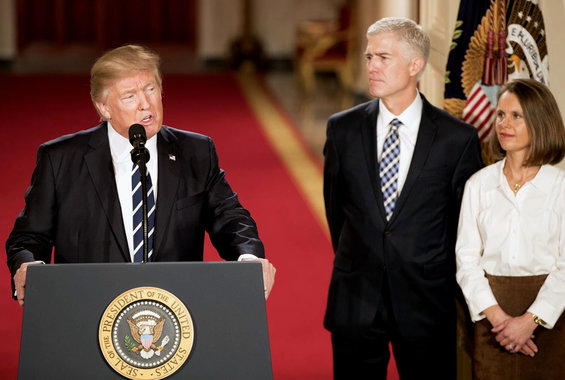
With all the dramatic flair fitting for a former reality television star, President Trump announced his Supreme Court pick at 8 p.m. last Tuesday from the East Room of the White House. Judge Neil Gorsuch will fill the seat left by the death of Justice Antonin Scalia, if confirmed by the Senate.
Both Gorsuch and the other finalist, Thomas Hardiman, were reportedly summoned to D.C., though Hardiman never leftf his home state of Pennsylvania. According to Press Secretary Sean Spicer, Gorsuch was flown to Washington in a military plane and delivered to the White House, unseen after avoiding the press stationed at his home.
The drama does not end with the announcement, though. Democrats vowed from day one of Trump’s term that they would oppose any candidate the president selected, and following the unveiling, redoubled their resistance efforts.
Senate Democrats refused invitations from the president to attend the White House reception for Gorsuch, and House Democratic Leader Nancy Pelosi said in a CNN Town Hall meeting that she considered the nomination to be a “very hostile appointment.”
Much of the anger stems from the refusal by Republicans to consider President Obama’s pick for the highest court, Judge Merrick Garland, last year. It looks as though Senate Democrats may be working to turn the tables on Republicans by employing a filibuster, which would require 60 votes for confirmation. The Senate is currently split 52-48 in favor of the GOP.
If this is the case, Republicans have threatened to rewrite the rules for confirmation so that only a simple majority of 51 votes is required. Democrats may want to save their firepower anyway: It is unlikely that Gorsuch will face any real trouble being confirmed, and between Justice Anthony Kennedy considering retirement and Justice Ruth Bader Ginsburg’s age, there could be other battles to fight with greater repercussions.
Gorsuch’s confirmation would restore the previous voting balance, with Kennedy as the swing voter in an otherwise 4-4 split. Gorsuch was confirmed for his current position as a judge for the 10th Circuit Court of Appeals in Denver unanimously in 2006. He holds degrees from Columbia, Harvard and Oxford.
The native Coloradoan is a conservative who believes in an original interpretation of the Constitution, but has voted for the liberal side of the coin in cases where he believes context requires it. Support for Gorsuch is centralized on his philosophical similarities to Scalia and his originalist interpretations of the Constitution.
Gorsuch is considered a threat to women’s rights, labor protection and public health rights. He has voted in favor of religious freedoms cases, stating that requirements for contraceptive provision as outlined in Obamacare disregard the rights of religious non-profits.
Gorsuch is Episcopalian, adding religious variety to a court previously occupied by five Catholics and three Jews, though he works to maintain a separation of individual personal beliefs from the law.
Considering Gorsuch’s educational background, the nomination was a bit of a surprise from the perspective that Trump’s platform emphasized “draining the swamp.” But his distinguished academic record and experience will make his appointment tough to block, and at age 49, Gorsuch will be able to cement Trump’s legacy for many years after the president leaves office, if confirmed.
All in all, the nomination is of strategic significance for Trump: Gorsuch’s experience makes the appointment tough to fight. Obstruction could shed a negative light on Democrats, and Gorsuch’s relative youth ensures a long-lasting impact. The choice also satisfies key Republican players, and Trump gets to say that he is “a man of his word” for keeping his campaign promise to reinstitute a conservative to the nation’s highest court.